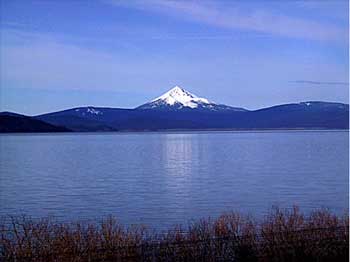Investigations of Sediment-water Interactions in Western U.S. Water Bodies

Investigations of Sediment-water Interactions in Western U.S. Water Bodies  |
||
|
BENTHIC
FLUX OF METALS AND NUTRIENTS PROJECT
|
||
|
 |
For the past 50 to 100 years large blooms of a near monoculture of blue-green alga Aphanizomenon flos–aquae (AFA) develop each summer in Upper Klamath Lake (UKL). Because the cyanophyte has an active buoyancy system that allows surface “scums” to be wind-concentrated, low dissolved oxygen concentrations develop in large parts of UKL when these blooms crash. The resulting hypoxia stresses two endangered sucker populations, including mass mortality of adults, suboptimal year-to-year survival, and poor recruitment. Decreasing jeopardy for suckers hinges on finding ways to improve lake water-quality by decreasing the severity of blooms and shifting the algal assemblage away AFA.
Problematic algal blooms are fueled by large external and internal loads of phosphorus (P). It is the internal loading from bottom sediments (benthic flux), however, that causes P lake concentrations to rise from 80 to 250 ug/L in late spring (typically June). Developing an understanding of the mechanisms controlling this benthic flux, and how long it would persist if external loads could be reduced, is necessary for developing sound remediation strategies and for setting realistic expectations for water-quality improvements. Possible remediation actions include watershed restoration in the Sprague River basin, restoration of wetlands upstream and around UKL, and chemically treating sediments in localize areas of UKL that may most contribute to internal loading.
Early hypotheses for internal P loading included: (1) wind-induced
resuspension of bottom sediments, (2) desorption of P from surface
sediments by high
pH waters induced by algal production, and (3) release of P from
ferric oxyhydroxide coatings on sediments exposed to reducing
conditions during
episodic thermal stratifications. These hypotheses have been discounted
by subsequent studies leaving the question unanswered as to the actual
process controlling benthic flux. This issue can best be resolved
by directly measuring gradients of dissolved ortho-P (and other
constituents)
across the sediment-water interface, calculating hypothetical benthic
flux rates, and testing additional hypotheses as to the possible
biological, chemical, and physical interactions that influence
flux rates.
Dissolved ortho-P is a particle reactive solute; meaning that it
can form surface complexes on a variety of mineral and biotic surfaces.
As particulate P settles in the lake, it accumulates in the bottom
sediments.
Various biogeochemical processes related to changes in acid-base
and
redox chemistry near the sediment-water interface can recycle that
P and generate a benthic flux of bioavailable P that may far exceed
external
sources.
This collaborative project with the Oregon Water Science Center is an effort to provide the first measurements of dissolved P benthic flux to the water column of Upper Klamath Lake both before and during the period of internal loading. Because of current considerations stated in the 5-year Plan for Lake Restoration to “increase humics released into the lake”, the study will also provide initial measurements of the benthic flux of dissolved organic carbon and trace metals to the lake (many trace metals are biologically reactive and complex strongly with dissolved organic ligands).
A USGS Open-File Report was published in September 2007 detailing the finding from field work completed in 2006 and 2007:
http://pubs.usgs.gov/of/2007/1276
Further implications and interpretations of the studies so far were published within Environmental Contamination and Toxicology in early 2009.
http://www.setacjournals.org/perlserv/?request=get-abstract&doi=10.1897%2F08-207.1
In early November, 2007, a series of detonations were used destroy levees and reconnect grazing lands (that once had been wetlands) to the lake. Two USGS Open-File Reports detailed the changes observed over the following years:
http://pubs.usgs.gov/of/2010/1062/
http://pubs.usgs.gov/of/2012/1057/
Lastly, the cover story for an issue of Environmental Toxicology and Chemistry applied further interpretation to the findings:
http://onlinelibrary.wiley.com/doi/10.1002/etc.v31.9/issuetoc
| Privacy || Disclaimers || Accessability || F0IA || Policies and Notices | |
URL
for this document is http://wwwrcamnl.wr.usgs.gov/solutetransport/index.html |
 |